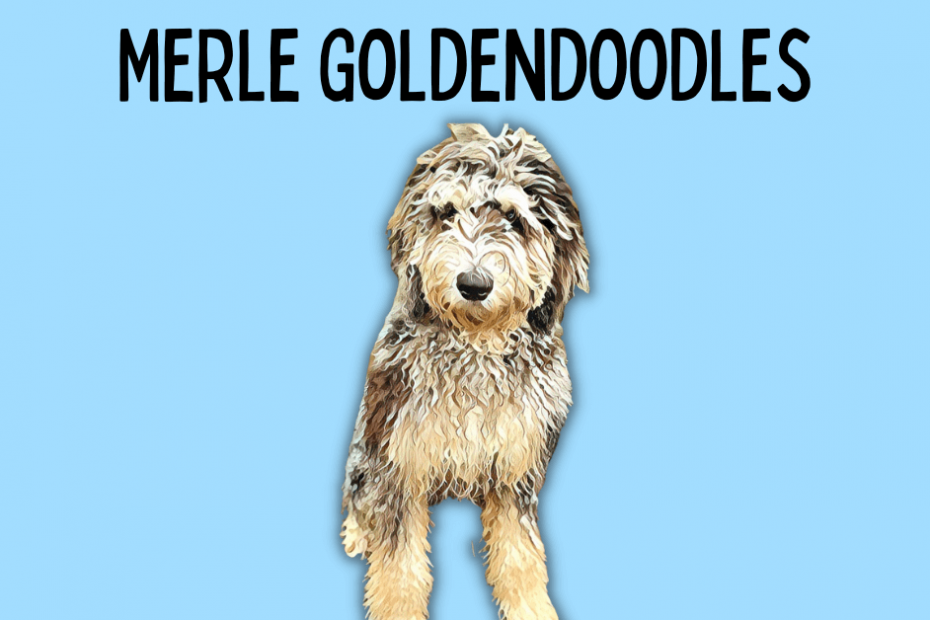Have you ever seen a Goldendoodle that has a striking pattern on its coat? It usually appears as uniquely-colored spots all around the body and face.
Or, maybe you’ve heard someone mention the phrase merle Goldendoodle.
Either way, this type of coat pattern is called a merle. It contains a specific pattern between light and dark hair in dog’s coats. This can create a striking color pattern with rare colors that many Goldendoodle breeders and owners enjoy.
In this article, I will go in-depth on the genetics behind merle Goldendoodles.
What is a Merle Goldendoodle?
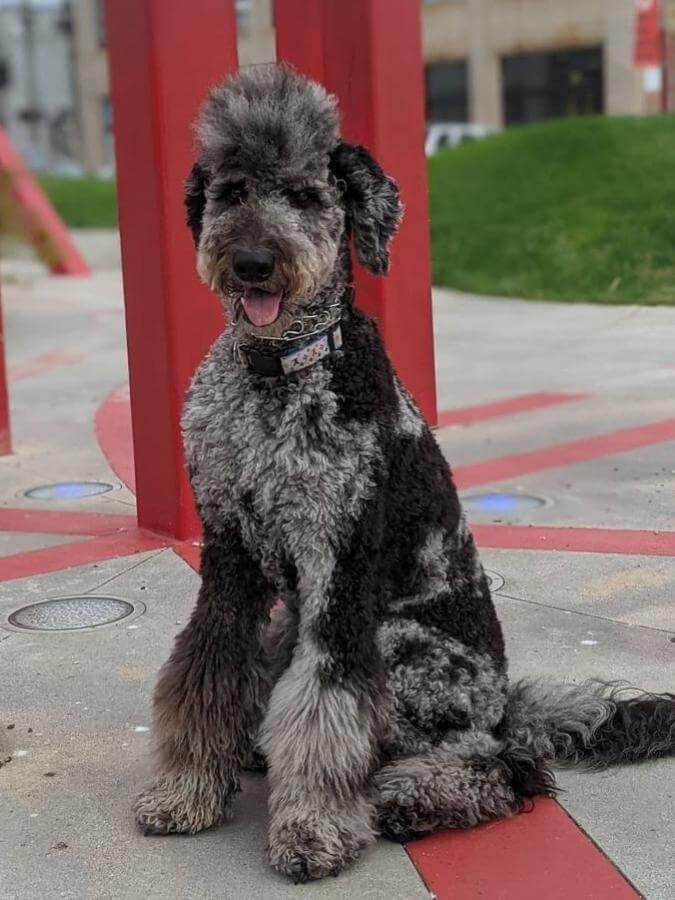
A merle Goldendoodle is a popular crossbreed between a Poodle and a Golden Retriever, which has a specific coat pattern called merle. These Doodle dogs are very popular due to their striking shades of black, brown, or a combination of the two.
Are they any different than a regular Goldendoodle?
No, merle Goldendoodles are the same as regular Goldendoodles. The Poodle-Golden Retriever mix has a variety of different coat colors. Some Goldendoodles have one solid color, such as apricot Goldendoodles, white Goldendoodles, brown Goldendoodles, etc.
Other Goldendoodles may have unique coats like brindle, parti, or merle. However, a merle Goldendoodle and a parti Goldendoodle are the same breed. Their coat color (or pattern) does not change the dog’s traits and characteristics.
So, how do merles get their gorgeous coats?
Merle Coats: The Science Explained
A merle coat has a mix of shades in patches on the dog’s coat. The extent of these shades and patches depends on genetics.
For example, a young dog with a salt-and-pepper appearance has the genetics for black coat color and merle coat pattern. If it’s blue and white rather than black and white (or grey), it probably has the genetics for dilute.
Dilute is where the hair color is lightened.
Let’s start with color
A dog with BB genetics has hair that will grow black (e.g., black Goldendoodle), while a dog with bb genetics will grow red (e.g., red Goldendoodle). This type of color genetics also appears in cattle, sheep, and cats, to name a few.
This doesn’t mean that the dog will be black or brown. It only means that if it can produce colored hair, it will show up in a shade of either black or brown. This can be independent of points, sable, or brindle coat colors, which we’ll discuss further below.
For different shades, there are three genes involved.
The first is dilution or dd. Black dogs or red dogs (such as black Goldendoodles or red Goldendoodles) will have DD genetics, allowing for full expression of the color in all its rich shades. However, a dog with dilute genetics, or dd, will produce a lighter shade of the color.
This gives you a dog that is born charcoal grey or tan. A dog that also has ii genetics will often be lighter. Depending on the depth of dilution, this could be coloring such as silver, fawn, or cream.

On the other hand, a dog that is GG will start black or dark grey and then continue to lighten as they mature. This differs from geriatric graying of an aging dog, which is caused by loss of eumelanin production and is typically limited to the face.
One additional gene, A, is the agouti gene. It has two different appearances. One controls the color appearing on the back versus the belly, while the other controls the pattern of color on individual hairs.
A dog with black on its back and tan underneath is one type of aa. A dog that has light hair with dark tips is another type of aa. This includes the sable color (e.g., sable Goldendoodles).
Tyrosinase, or albinism, is a genetic mutation that prevents pigment from forming at all and is often seen in some white dogs that often have red or pale blue eyes and completely pink skin. This can cause many health problems to the dog, similar to what we’ll discuss in double-merle dogs below [1]munster.sasktelwebsite.net/DogColor/dogcolorgenetics.html
Let’s consider markings
Many dog breeds will have different genetics to add masks, spots, and similar changes in the coat color that is different from merle. A mutation in the MITF gene causes a white spot on the chest, like a Tuxedo Goldendoodle.
Other types of spots are due to mutations in this gene and others. This includes masks, points, piebald, flashy spotting, brindle, ticked, roan, and dalmatian spotting.
Harlequin creates amazing spotting patterns found only in Great Danes with one or two merle genes in addition to a single H gene. Great Danes are the only breed that has the true harlequin gene [2]doggenetics.co.uk. This means that no matter what you read, there is no such thing as a harlequin Goldendoodle.
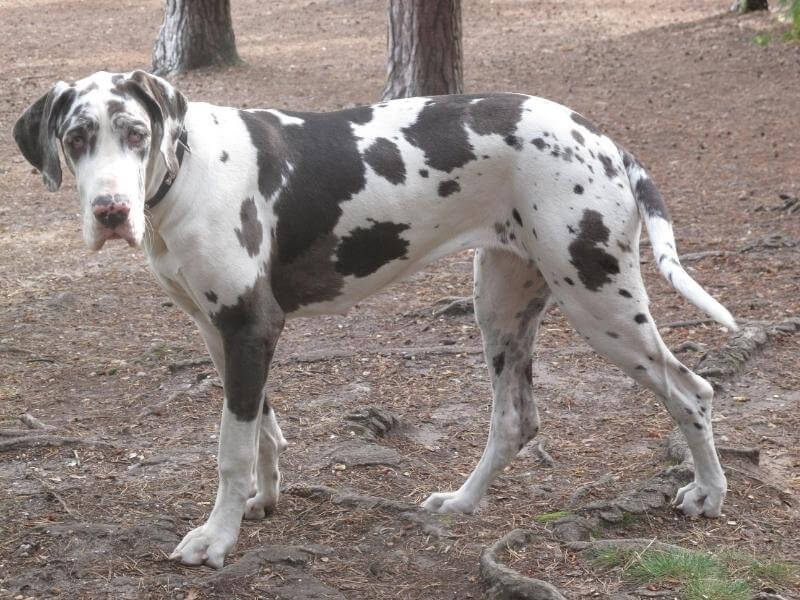
Merle Genetics: Behind the Scenes
Let’s look at the science involved in the merle coat pattern itself. Now that we understand the color and marking genetics, the merle gene provides an interesting scientific study.
Merle is passed on by the M locus, with non-merle being a double mm. The double mm is considered recessive genes. If you’re considering purchasing a merle Goldendoodle, make sure to ask whether it is Mm heterozygous, as MM, or double-merle, which can have serious health problems, which we’ll discuss below.
However, even within Mm dogs, you’ll see significant differences in how much of the merle pattern shows up.
The merle pattern is caused by what’s called a SINE insertion. What this means, in plain English, is that additional genetic code is inserted into a specific location on the M locus. The length of the insertion controls how much of the merle pattern shows up in the dog’s coat, with the length going from 200 to 280.
Dogs that are Mc, having an insertion length between 200-230, are referred to as cryptic or phantom merle because you won’t be able to see the merle in their coat. It will appear only in their offspring if passed onto a puppy with another M gene. Even then, it will be faint.
This explains why we might have cryptic merle Goldendoodles and phantom merle Goldendoodles.
At higher insertion lengths, more marked patterns will appear. An Mc+ will have very faint merle patterning and is often still referred to as a cryptic merle, and has an insertion length of 231-246.
Atypical merle is an Ma with a length of 247-254 or an Ma+ with a length of 255-264. With one copy of the atypical merle locus, the dog will have no to slight merle markings, while two copies will look like a regular Mm merle pattern in many cases [3]doggenetics.co.uk/merleadvanced.
Insertion lengths that can pose dangers for breeding
For Mc, you can breed to any other merle genetics except Mc+, Ma, and Ma+. These should never breed to dogs that have longer alleles to avoid the chance of health problems in puppies.
A merle or M has an allele insertion length of 265-268, providing the usual merle coat pattern in an Mm dog. However, two Mm dogs have a chance of producing an MM or double-merle puppy, which can have significant health problems.
This type of breeding should be avoided.
A harlequin merle or Mh has the longest allele insertion length between 269-280 and may also be referred to as a herding harlequin in some breeds. This type of breed will often have large white or pale grey patches.
This happens because the strength of the genetic expression removes some of the darker coloring while retaining the merle pattern. This type of genetics must be bred to unmerled, or Mc, dogs to prevent the risk of severe health problems in puppies.
How Can a Goldendoodle be Merle?
As a cross between Poodles and Golden Retrievers, merle Goldendoodles get their merle genetics from the Poodle. But many breeders, and Poodle-fanatics, believe that there is no such thing as a merle Poodle.
The reason for this belief is that Poodles don’t have merle genetics. This isn’t true. An intentional genetic bottleneck caused the merle genes in Poodles.
As an example, we’ll briefly look at Shetland versus Columbia sheep breeds. Columbias, prior to the Industrial Revolution, came in all colors, as the primitive Shetland breed still does.
But as chemical dyes replaced natural dyes in the Industrial Revolution, wool merchants began demanding white sheep so that the dye would present the same color across all the wool they had purchased.
Sheep farmers began breeding for white sheep. This is how the concept of a black sheep being a bad thing came into practice. Most people today believe sheep are all white because they haven’t seen the beautiful multicolored primitive breeds being kept in conservancy programs.
Similarly, at one point in the history of the Poodle breed, colored Poodles were considered defective. As a part of that “defect,” merle genetics became fairly rare in the breed, even as colors and merle coat patterns were deemed acceptable to the breed standard.
However, as our appreciation of the breed and understanding of genetics has increased, more breeders have begun breeding for specific colors and merle patterns. If safely done, intentional breeding provides us with a beautiful, natural range of animals that were nearly bred out of existence.
After crossbreeding with Golden Retrievers to create the Goldendoodle breed, more color has been added to their genetic pool. Goldendoodles have a massive range of fantastic coat colors and patterns [4]valaurahfarms.com/the-merle-gene.
It is not uncommon to come across all sorts of colors and patterns in this designer dog:
- Blue Goldendoodles
- Phantom Goldendoodles
- Cream Goldendoodles
- Abstract Goldendoodles
- Chocolate Goldendoodles
- Tan Goldendoodles
- Gray Goldendoodles
What types of merle Goldendoodles are there?
As mentioned above, merle is essentially a coat pattern, which may include different colors or markings to create a specific color or pattern. These include five different options within each classification, which have a range of phenotypes or appearances.
Blue Merle Goldendoodle
Also referred to as black merle, a blue merle Goldendoodle has BB, a dominant gene, for its black pigment coloration, as well as DD for merle that is black with blue or white. In contrast, dd has merle that is blue with white, depending on the specific color and dilute genetics and the merle intensity [5]doggenetics.co.uk/merlecont.html.
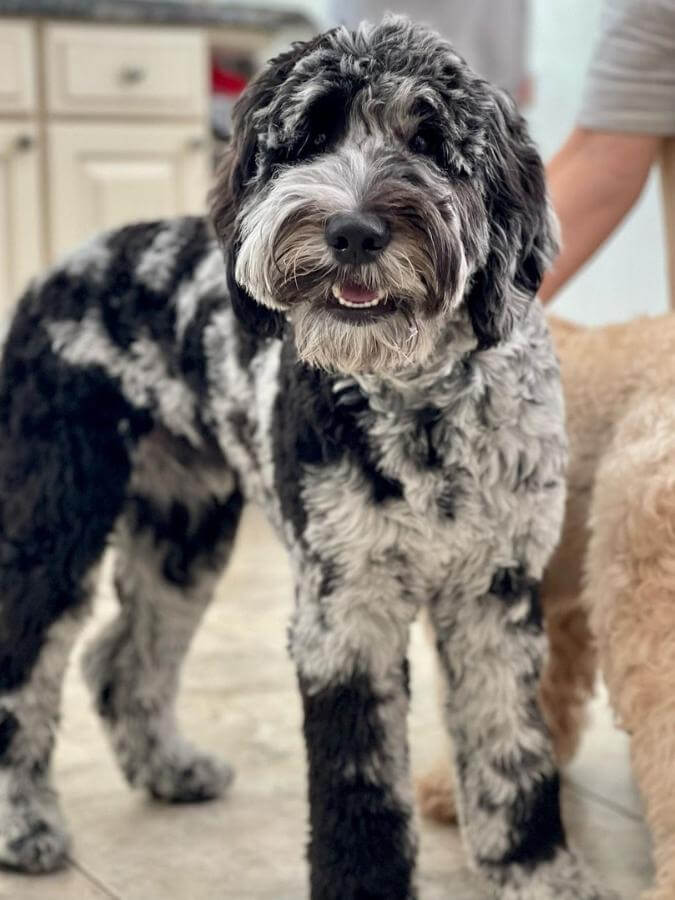
Red Merle Goldendoodle
Also called liver merle, a red merle Goldendoodle can include fawn or isabella coloration with dilution. These dogs have bb for their pigment coloration, resulting in a beautiful reddish-brown color.
Merle Goldendoodles with DD dilution will be darker brown or red with fawn, isabella, or white mixed in. dd dilution will result in a fawn or isabella dog with white markings mixed in [6]doggenetics.co.uk/merlecont.html.
Sable Merle Goldendoodle (Chocolate Merle Goldendoodle)
Referred to as tan or chocolate merle, sable merle has bb coloration and two specific genetics for agouti. The kyky allele must be present for the agouti pattern to show, and the dog must have at least one Ay allele on the A gene to show a solid red that may or may not have black tips on its hairs, with merle patterning in areas with black tipping [7]doggenetics.co.uk/merlecont.html.
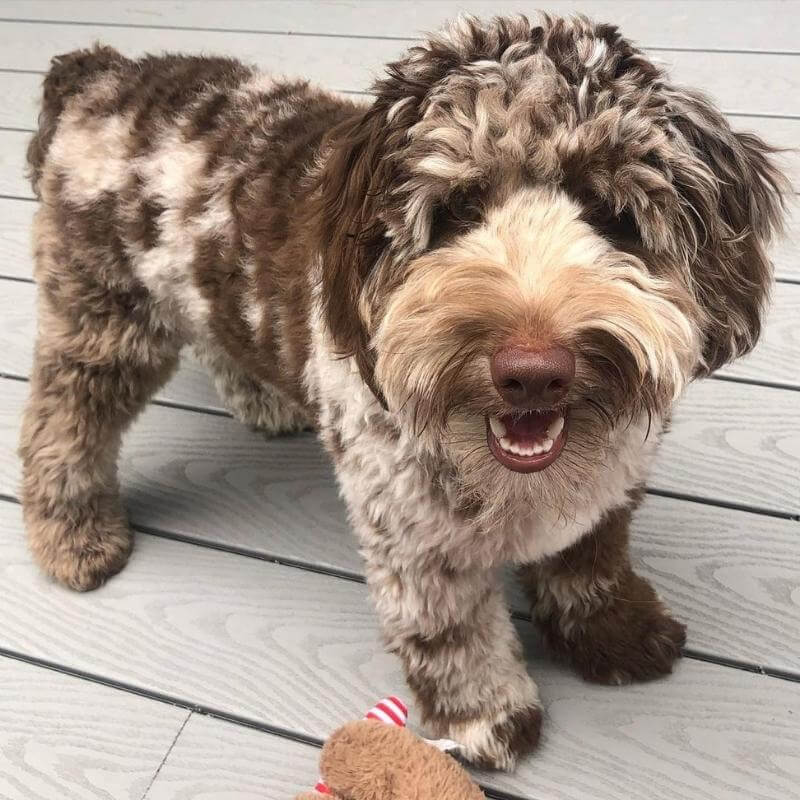
Brindle Merle Goldendoodle
Brindle is a black-and-brown or blue-and-fawn striped pattern that can appear in addition to the merle coat pattern, resulting in some absolutely stunning Goldendoodles. As a result of kbr genetics, the agouti locus controls how it shows up.
An atat dog has tan markings, but with kbr, the markings will be brindled. An AyAy dog, on the other hand, will be a red merle with broken black striped markings all over [8]doggenetics.co.uk/merlecont.html.
Cryptic Merle Goldendoodle (Phantom Merle Goldendoodle)
Sometimes referred to as phantom merle, a cryptic merle is a dog with the genetics for merle, but their allele length is too short to show the phenotype or merle pattern coat. These dogs will appear as any other Goldendoodle that does not have a merle coat but should be genetically tested if used for breeding [9]doggenetics.co.uk/merle.html.
Are Merle Goldendoodles Healthy?
For the most part, merle Goldendoodles are just as healthy as any other Goldendoodle. That is, so long as you buy from an experienced, reputable breeder.
A breeder who knows what they’re doing understands the complexity of merle genetics and how to avoid breeding homozygous dominant MM double-merle puppies. But what’s so wrong about breeding double-merle?
The dangers of double merle…
The merle coat pattern, as mentioned above, reduces a dog’s ability to produce eumelanin. This causes lighter hair to be interspersed with darker hair. In a heterozygous Mm dog, this creates a beautiful merle coat pattern or a cryptic merle.
However, homozygous MM further reduces the dog’s ability to produce eumelanin, which creates large patches of white or pale grey. This is similar to Harlequin merles, but often on an even more dramatic scale. Though these dogs are not usually completely albino, they will often have many of the same health issues that albino animals have.
Possible health issues from double merle
A homozygous MM double-merle Goldendoodle will have a great deal of white fur, which may look pretty, but it hides a sinister issue. Many double-merle Goldendoodles are blind or have underdeveloped eyes. They may have problems with deafness.
The MM genetics can also cause many problems with the central and peripheral nervous system, leading to dogs that will go through their lives with significant disabilities and difficulties adjusting to the outside world.
I strongly recommend you avoid these dogs and breeders who breed them to help discourage this unethical practice.
Unethical Merle Goldendoodle Breeding
Breeders should have one purpose in their program: breeding for health, conformation, and temperament.
However, breeding can be like playing genetic poker. They have an idea of how certain cards will play together but can never be sure until the litter is born.
For that reason, good breeders will follow ethical breeding practices that result in exceptional animals. If they get unusual coat patterns, that’s just a bonus because those unique coat patterns, such as merle, sell for higher amounts.
By comparison, unethical breeders may breed two merles together in the hope of getting more merles to sell for a higher cost. Unfortunately, this also produces double-merle puppies, which can suffer significantly due to blindness, nervous system problems, and deafness.
Because of their pink skin, especially noses and inner ears, these dogs are also much more prone to skin cancer, causing significant pain and suffering, all in the interest of bringing in more money from the merles they produce in the same litter.
Extremely unethical breeders may even sell double-merle puppies, lying about or diminishing the effects these genetics can have on the puppy at the time or the grown dog in the future.
When working with a breeder, always ask to see both parents and what genetic testing has been done on the parents. This allows you to make an informed decision about which puppy you should choose when you have the opportunity. This significantly improves the odds that you’ll have a healthy, happy Goldendoodle to share your life with for many years.
Summary
Merle Goldendoodles are gorgeous. Their striking colors and unique patterns add a wonderful spice to the already wonderful Goldendoodle dog breed. Just make sure you are careful to avoid any breeders that are attempting to breed double merles!
Key Takeaways
- Merle is a unique coat pattern that is seen in Goldendoodles.
- There are four degrees of merle coat dominance: cryptic, atypical, merle, and harlequin.
- Five different coat patterns and colors appear blue, red, brindle, sable, and cryptic.
- Double-merle Goldendoodle puppies regularly have significant health challenges due to poor genetics.
- Always buy from an ethical Goldendoodle breeder who can provide details on parentage.
This article was written by Cathleen V. She has a Master’s of Science in Biology and breeds sheep in the state of Missouri.


